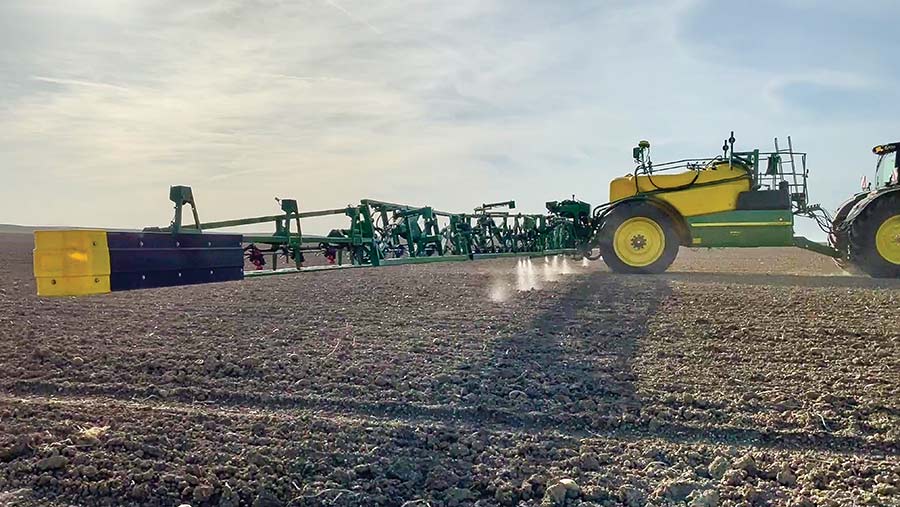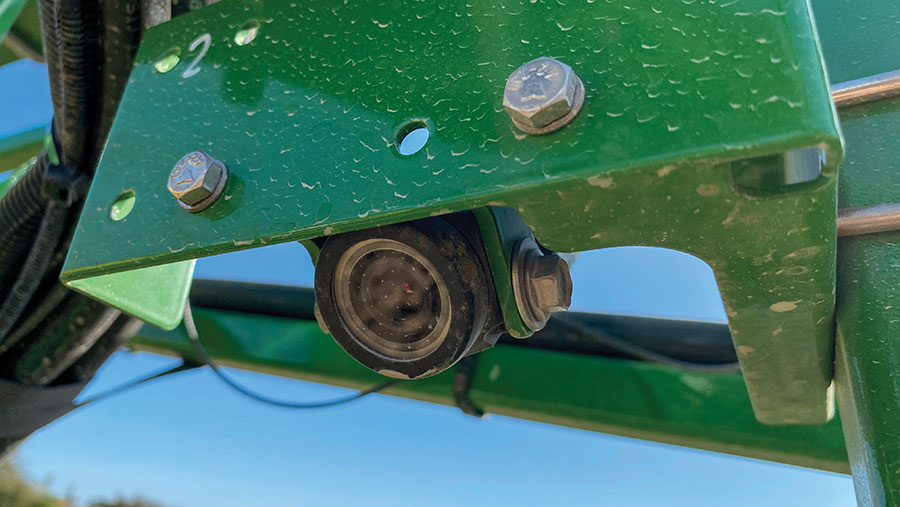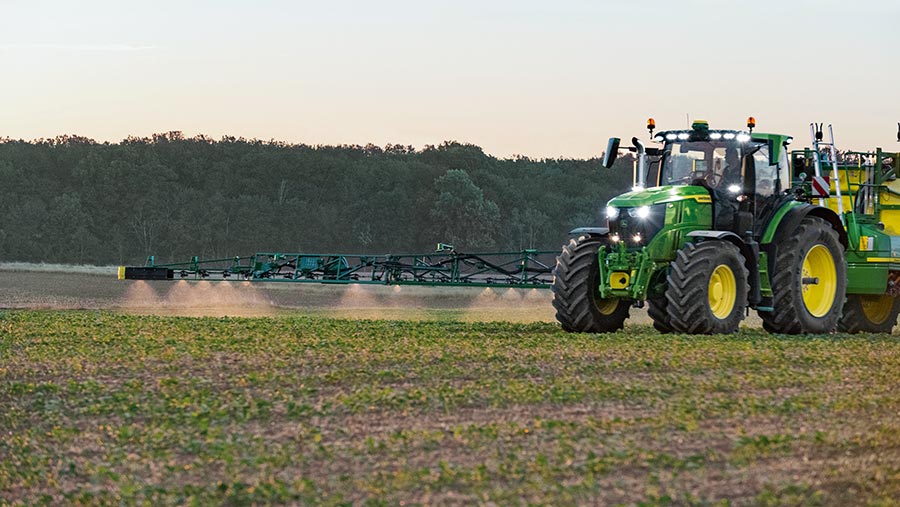Spot spraying option coming to John Deere’s trailed R-series
 © MAG/Oliver Mark
© MAG/Oliver Mark John Deere is finally ready to roll out its spot spraying system in Europe, five years after its $305m (£250m) acquisition of Californian start-up Blue River.
The See & Spray kit will be available as an option on 36m and 39m R-series trailed sprayers built in Horst, the Netherlands, although, somewhat underwhelmingly, buyers will only have access to the Select iteration which is limited to so-called “green-on-brown” detection.
See also: Scottish entrepreneur builds spot spraying tech on a budget
This has the capacity to differentiate between growing plants and soil or trash, switching individual nozzles on and off to target weeds prior to the crop emerging.
As such, its use will be restricted to a relatively small autumn or spring window.
While this might not seem like much of a progression from the WeedSeeker and Weed-It systems that have been popular in Australia and the US for decades, the way it works is markedly different.
Rather than using relatively simple infrared sensors to detect live plant matter, Deere employs colour cameras to make the distinction.
In the future, the same hardware will be combined with far more sophisticated software capable of identifying and spraying particular species within growing crops – something already being achieved in the UK by the likes of Trimble-owned Bilberry.
Deere actually offers this service in the US, where buyers can now bag self-propelled 400R and 600R machines equipped with Premium or Ultimate spec versions of See & Spray for use in maize, soya beans and cotton.
The holy grail remains targeting grassweeds in cereals but, given their similarities in appearance and close row spacings, John Deere says a commercial offering remains a long way off.

© John Deere
How does it work?
In Europe, the system is designed to work on trailed R-series models, as these come equipped with Deere’s PowrSpray twin-pump setup – one rated to 1,200 litres/min for filling and a second 750-litre unit for spraying.
Having a centrifugal pump dedicated to keeping the plumbing lines primed ensures there is the capacity to react to rapid changes in pressure, which is essential given that the quantity of liquid being applied is in perpetual flux.
The electric solenoids that control the nozzles constantly flicker as weeds are detected, so in just a few seconds it can switch from jettisoning liquid from a single nozzle to engaging all 72.
To do this, a series of Go Pro-sized colour cameras, dotted at 1m intervals, harvest a constant feed of images 80cm ahead of the boom.
These work at 30 frames a second, delivering a fresh picture every 10cm at the 12kph forward speed Deere recommends for the most efficient combination of accuracy and output.
They produce a vast amount of information that is analysed by five high-powered image processors, each one charged with dissecting 27sq m of image data a second.
They can spot a weed as little as 6mm in size and, in milliseconds, determine whether it warrants dousing in herbicide.
Operators can alter the margin for error on the in-cab screen by adjusting the resolution to increase or decrease the size of plant necessary to trigger a nozzle.
It’s also possible to increase the pool of spray applied to a given weed, extending the length of time and number of nozzles that are opened to ensure complete coverage of the target.
As it stands, See & Spray only works with 120deg nozzles spaced at 50cm. This setup keeps the boom higher and allows the cameras to see further forward, giving more time for the system to react.
However, Deere intends to adapt it for 25cm spacings in the future.
Although this will improve accuracy – and thus reduce the amount of spray wasted on barren ground – it will rely heavily on the boom stability provided by its five-sensor Terrain Command Pro system.
Fully integrated
John Deere isn’t the first maker to offer such a system in the UK – the likes of Agrifac and Dammann already have machines in the field, some of which are capable working in a green-on-green scenario – but it has the advantage of building both the sprayer and weed detection kit in-house.
This allows the cameras and controllers to be fully integrated into the boom structure which, the company says, makes them better protected from the elements and also speeds up processing time.
The downside is that there is no retrofit option, which rules out fitting it to an existing sprayer.
It’s not yet isobus compatible either – it only works with John Deere’s latest G5 display and Starfire 7000 receiver, and relies on JDLink software to transfer data to and from the farm office.
Through the firm’s Operation Center, this information can be used to populate weed maps for future reference, document spray tasks and calculate herbicide savings in a field versus a blanket application.

© John Deere
Row crop detection
Although the first iteration of See & Spray is relatively crude, in that its target amounts to anything green, there is scope for using it later in the growing season.
That’s thanks to a clever bit of software that learns the position of wide-spaced oilseed rape, sugar beet, potato and maize crop rows.
These are then ignored, meaning the nozzles are provoked into action only when a plant is spotted in the gap between them.
As the nozzles have plenty of overlap, the crop row is likely to take a herbicide hit too – no bad thing given weeds tend to appear in clumps.
In theory, this means the system can be used until the canopy closes, but the hit rate of sprays will inevitably diminish as weeds become concealed by crop leaves.
The system might also prove useful for growers desiccating potatoes.
The initial spray-off will still require a full-width, blanket application, but a second pass can be completed using See & Spray to target only surviving plants.
And Deere has conducted tentative trials in Denmark to assess the effectiveness of spraying off cereals pre-harvest, primarily to knock out green plants in tramlines without the expense of a full-width spray.
How much will it cost?
The price is as yet unknown, but it will be expensive.
The quintet of computer gaming-grade processors alone are estimated to cost about €7,500 (£6,500), plus there are at least 36 colour cameras and all the other gubbins that join it together.
Deere is currently awaiting conclusive results on the cost savings at its test farms before determining how much customers might be willing to pay.
And those figures are wholly dependent on weed pressure – the cleaner the fields, the greater the saving compared with a blanket application and, therefore, the more valuable the proposition.
However, the first See & Spray Select system pressed into action in Europe, on a farm in France, has proved a success, delivering a significant reduction in both weed burden and chemical cost.
Damien Menuel, who farms 800ha and contracts a further 200ha in the Champagne region, has been running a See & Spray-equipped R-series for two seasons.
“It’s as effective as a broadcast application in killing weeds, and last year we saved 30% on our herbicide costs,” he says.
“Using less chemical means we can afford to use expensive products at full rate, hit the blackgrass early and regularly, and there is far less chance of resistance building up.
“The downsides are that forward speeds are limited and the camera system only works in daylight.”
Damien has also overcome the challenge of knowing exactly how much chemical to put in the tank, given that the required volume is unknown.
He explains: “I spray the fields with the lowest weed pressure first and save the weediest until last.
“Once I get to them, I have a good idea how much chemical I will need, so there is no need for guesswork.”
US leads the way
John Deere’s European spot spraying offering is lagging a long way behind that of the US.
There, customers already have access to more advanced versions of the See & Spray system on 400R and 600R self-propelleds.
Both Premium and Ultimate versions use artificial intelligence to selectively target species in maize, soya beans and cotton – wide-row crops that are easily distinguished from common weeds.
The Ultimate spec includes a twin tank on the sprayer, so two mixes can be applied at different rates to treat broad-leaved weeds and grassweeds separately, or a targeted spray can be applied in the same pass as a residual herbicide or fungicide application.
For European buyers yearning for a similar approach to grassweed control in cereals, such flexibility and complexity will have to wait.
The development process, by Deere’s own admission, will be long, slow and challenging.

